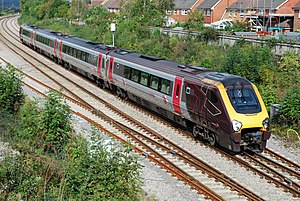Our website is made possible by displaying online advertisements to our visitors.
Please consider supporting us by disabling your ad blocker.
British Rail Class 220
| British Rail Class 220 Voyager | |
|---|---|
 CrossCountry Class 220 in 2010 | |
 Standard Class interior | |
| In service | 2001–present |
| Manufacturer | Bombardier Transportation |
| Built at | |
| Family name | Voyager |
| Replaced | |
| Constructed | 2000–2001 |
| Number built | 34 |
| Formation | 4 cars per unit |
| Fleet numbers | 220001–220034 |
| Capacity | 174 standard class, 26 first class |
| Owners | Beacon Rail[1] |
| Operators | CrossCountry |
| Specifications | |
| Car body construction | Steel |
| Car length | 23.85 m (78 ft 3 in) (driving cars) or 22.82 m (74 ft 10 in) (intermediate cars) |
| Width | 2.73 m (8 ft 11 in) |
| Wheel diameter | 780–716 mm (30.7–28.2 in) (maximum–minimum)[2] |
| Wheelbase | Bogies: 2.250 m (7 ft 4.6 in)[3] |
| Maximum speed | 125 mph (200 km/h) |
| Weight | 185.6 t (182.7 long tons; 204.6 short tons) per unit |
| Traction system | One per car, Alstom alternator, 750v asynchronous ONIX IGBT drive with AGATE traction control, asynchronous traction motors (2 per car) |
| Prime mover(s) | 4 × Cummins QSK19-R[4] (one per car) |
| Engine type | Inline-6 turbo-diesel[5] |
| Displacement | 19 L (1,159 cu in) per engine[5] |
| Power output | |
| Transmission | Diesel-electric |
| UIC classification | 1A′A1′+1A′A1′+1A′A1′+1A′A1′[3][6] |
| Bogies | Bombardier B5005[3] |
| Braking system(s) | Rheostatic and electro-pneumatic |
| Safety system(s) | AWS, TPWS |
| Coupling system | Dellner 12[7] |
| Track gauge | 1,435 mm (4 ft 8+1⁄2 in) standard gauge |
The British Rail Class 220 Voyager is a class of diesel-electric high-speed multiple unit passenger trains built in Belgium by Bombardier Transportation in 2000 and 2001. They were introduced in 2001 to replace the 20-year-old InterCity 125 and almost 40-year-old Class 47-hauled Mark 2 fleets operating on the Cross Country Route. They were initially operated by Virgin CrossCountry and since 2007 have been operated by CrossCountry.[8]
- ^ Sherratt, Philip, ed. (2023). "ROSCO Fleets". Modern Railways: Review 2023. Stamford: Key Publishing. pp. 18–19. ISBN 978-1-80282-569-5.
- ^ Cite error: The named reference
bowas invoked but never defined (see the help page). - ^ a b c d References: High-Speed Trains and Electric Multiple Units (EMUs) (PDF). Heidenheim: Voith Turbo. May 2008. pp. 20–21. Archived from the original (PDF) on 2 December 2022. Retrieved 2 December 2022.
- ^ Diesel Multiple Units 2010. Sheffield: Platform 5 Publishing. 2010. p. 66. ISBN 978-1-902336-75-6.
- ^ a b Every Track - QSK19 for Rail Applications (PDF) (09/08 ed.). Daventry: Cummins Ltd. Bulletin 4087201. Archived from the original (PDF) on 2 December 2022. Retrieved 2 December 2022.
- ^ "Cutting noise and smoothing the ride". Railway Gazette. London. 1 August 2000. Archived from the original on 4 June 2012. Retrieved 20 December 2010.
In the Voyager application, every car has a Cummins underfloor engine and alternator supplying power to a pair of body-mounted traction motors. Each drives one inner axle through a cardan shaft and axle-mounted final drive gearbox. Thus all 272 bogies are identical
- ^ System Data for Mechanical and Electrical Coupling of Rail Vehicles in support of GM/RT2190 (PDF). London: Rail Safety and Standards Board. 22 June 2011. p. 4. SD001. Archived from the original (PDF) on 1 April 2012. Retrieved 22 November 2022.
- ^ "New Dawn for Virgin Trains" (Press release). Virgin Trains. 5 June 2001. Archived from the original on 19 June 2009. Retrieved 13 February 2009.
Previous Page Next Page


